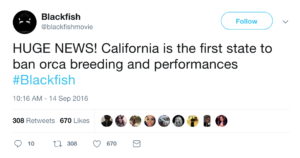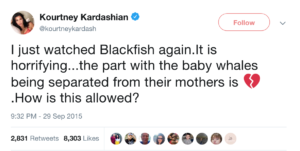The sinking of SeaWorld: how Blackfish made an impact
![]()

Figure 1 – SeaWorld’s stock price can be seen peaking before Blackfish was released. Its drastic fall can be seen as a result of the impact that Blackfish had on the public [1]
Gabriela Cowperthwaite’s film, Blackfish (2013) premiered at the Sundance film festival on January 19th 2013. By the beginning of August 2014, SeaWorld’s stock price had fallen by nearly 60%[2]. The global impact that Blackfish has had, and continues to sustain 5 years following its release, can be attributed to the film’s utilisation of a range of tactics throughout various stages of the film’s development.
When SeaWorld trainer, Dawn Brancheau, was killed by Tilikum, a captive performing orca whale, SeaWorld quickly attributed her death to her ponytail swinging in front of Tilikum[3]. Cowperthwaite didn’t believe that “this” was the only reason. This disbelief led her to uncover the truth behind SeaWorld, and how SeaWorld’s maltreatment of orcas has led to the subsequent violent nature of many of its animals. This case study will look at various tactics used by Blackfish in order for the film to have an impact.
Blackfish is a ‘story of dual tragedy – human and captive whale’[4]. Cowperthwaite plays on the emotion of empathy in the film to make an impact on the spectator in addition to shifting the blame from Brancheau and Tilikum and placing it on SeaWorld. Within the first 10 minutes of the film the spectator is told about whale pods being like families, and the traumatic separation of calf and mother is recounted and shown through footage. Tilikum is then described as being eager to please and a joy to work with by his former trainers in interviews. Interviews are used throughout the course of the film as means of allowing those speaking out against SeaWorld, a platform to engage openly with issue at hand as well as be transparent with their emotions and memories with the spectator. These aforementioned elements work within the film work to humanize whales (Tilikum specifically), allowing the spectator to empathise with whales who have been taken from their families. It is through the establishment of these similarities and humanistic traits of the whales that the spectator is led to feel equally empathetic for Tilikum as they are for Brancheau who was killed.
 [5]Figure 2 – Clip from the film explaining the separation of orca calves from mothers. Note the use of the word baby and not whale.
[5]Figure 2 – Clip from the film explaining the separation of orca calves from mothers. Note the use of the word baby and not whale.
Cowperthwaite again plays on evoking an emotional response, in this case shock and horror, through the detailing of the graphic details of Brancheau’s death in the film. A combination of “911” audio from the night of the incident, along with the coroner’s reports, prompt this emotional response from the spectator – leaving a lasting impact. However, the choice to emphasise the specific details of Brancheau’s death lends itself to questioning whether her death was used as an honest attempt to elicit an emotional response from the spectator and share Brancheau’s story, or whether her death was sensationalised as a means of proving a point.

[6]Figure 3 – Clip from the film, detailing Brancheau’s autopsy
In order to maximise public interest, publicity and visibility of the film, Cowperthwaite employed strategic distribution as a tactic. Blackfish is known for having ‘a near-perfect multifaceted distribution strategy primed for visibility’[7].
Film festivals are known to generate social advocacy, aid ‘in commercial agendas for distribution’[8], and direct ‘attention to an issue or cause’[9]. Cowperthwaite’s choice to premiere Blackfish at Sundance in 2013, meant that the film was able to harness the aforementioned benefits, and was subsequently picked up for distribution by CNN and Magnolia Pictures. Through CNN’s distribution, the film was placed in ‘a synergistic publicity and news media machine’[10]. CNN strategically released SeaWorld segments and interviews leading up to the film’s premiere, which created public anticipation and generated publicity organically.
Blackfish was later released on Netflix[11], a global streaming site, allowing the film to be accessible in 7 highly populous countries[12]. This increased visibility has allowed Blackfish to remain impactful over time. Through its strategic distribution, Blackfish sparked ‘widespread outrage that spilled over onto social media’[13]. This suggests that the various tactics utilised by Blackfish are interconnected and lend themselves to helping the film have a bigger impact.

[14]Figure 4 – Example of the Blackfish Twitter account engaging and informing followers
‘It’s imperative that independent films find and engage with their audience on social media’[15], and Blackfish has done just that. The film utilises Twitter, as a cost-effective, efficient, and engaging method of interacting with spectators, thus furthering its impact. Blackfish’s presence on Twitter is notable, with 60.1k followers and the hashtag #Blackfish being used over 2,000 times[16] this week alone [17]. As Blackfish gained mass public interest, celebrities took to Twitter, vocalizing their outrage at what was uncovered in the film. Celebrity tweets work by endorsing the film through magnifying ‘public awareness about the story’[18], as a result of their relative position of power in the media.

[19]Figure 6 – Celebrity Kourtney Kardashian (socialite, 23.7 million followers) tweeting about the film
Through Blackfish’s active engagement on Twitter, affected spectators have been granted a platform to express opinions and advocate. This has been facilitated by the use of specific hashtags such as #ThanksButNoTanks and #DontGoToSeaWorld. Engagement with specific hashtags additionally has established a virtual community of twitter users, connected by their outrage at the subject matter. The impact of Blackfish’s engagement with virtual communities on Twitter lies within the spectator feeling as though they are part of a bigger group, who collectively use twitter as a platform for visible activism.

[20]Figure 8 – Example of Twitter user engaging in the virtual community of #Blackfish, simultaneously promoting the film and shaming SeaWorld
SeaWorld recognised the impact that Blackfish had on twitter users, and responded by starting their own hashtag, #AskSeaWorld, in aims of re-establishing their public image[21]. This however backfired as they were inundated by countless accounts of internet trolling, resulting in them being placed on the 2015 list of media misfires[22].

[23]Figure 9 – An example of a Twitter user ‘trolling’ the #AskSeaWorld
SeaWorld is still ‘fighting for its survival post ‘Blackfish’’[24]. The impact of the film can be seen from SeaWorld’s evident financial losses to even Pixar altering the ending of Finding Dory in response to the film[25]. Blackfish succeeds in achieving its goal of exposing both the danger that SeaWorld trainers were unknowingly placed in, in addition to explaining how the aggressive nature of Tilikum, was a direct result of the trauma faced in captivity. The impact of using emotion as a tactic is individual to the spectator’s response. However, the integration of interviews into the film adds a sense of authenticity to what is being said in the film. The tactic of strategic distribution of the film has resulted in an impact of the issues within the film reaching a global audience, in addition to the film being given the ability ‘to renew itself and keep the issue in the public and journalistic spotlight’[26]. Through actively engaging on Twitter, Blackfish has not only garnered an online community, but has shown how twitter as a platform, can be used for activism. The various tactics used within Blackfish, demonstrate how documentary ‘can be a powerful form of journalism capable of bringing about change’[27].
[1] Image source: https://www.washingtonpost.com/news/wonk/wp/2014/12/12/chart-what-the-documentary-blackfish-has-done-to-seaworld/?utm_term=.36f8ad5be803
[2] Roberto Ferdman, “Chart: what the documentary Blackfish has done to SeaWorld”, Washington Post
[3] Lee Ferran and Russell Goldman, “SeaWorld Curator: Ponytail likely caused fatal killer whale attack”, ABC News
[4] David Hickman, “Blackfish: proof that documentary can be a powerful force for change”, The Conversation
[5] Image source: https://www.netflix.com/watch/70267802?trackId=13752289&tctx=0%2C0%2C5f4a95669a98546de1d3b7f190b5041e811b92da%3A1622e3688602e361f0c99a239a4ec9b9494202f8%2C%2C
[6] Image source: https://www.netflix.com/watch/70267802?trackId=13752289&tctx=0%2C0%2C5f4a95669a98546de1d3b7f190b5041e811b92da%3A1622e3688602e361f0c99a239a4ec9b9494202f8%2C%2C
[7] Caty Borum-Chattoo, “Anatomy of ‘The Blackfish Effect’”, International Documentary Association
[8] Leshu Torchin, Networked for Advocacy: Film Festivals and Activism (2012)
[9] Leshu Torchin, Networked for Advocacy: Film Festivals and Activism (2012)
[10] Caty Borum-Chattoo, “Anatomy of ‘The Blackfish Effect’”, International Documentary Association
[11] Caty Borum-Chattoo, “Anatomy of ‘The Blackfish Effect’”, International Documentary Association
[12] Information taken from http://unogs.com/
[13] John Titlow, “SeaWorld is spending $10 million to make you forget about Blackfish”, Fast Company
[14] Image source: https://twitter.com/blackfishmovie/status/776107439427088385
[15] Jess Fuselier, “Unrest case study”, Sundance.org
[16] Information gathered from tweetbinder.com
[17] At time of print (15/11/18)
[18] Caty Borum-Chattoo, “Anatomy of ‘The Blackfish Effect’”, International Documentary Association
[19] Image source: https://twitter.com/kourtneykardash/status/649079374763851776?lang=en
[20] Image source: https://twitter.com/DElenaTimeless/status/894257816692600832
[21] Donald Bellisario, “Case Study: SeaWorld’s Response to “Blackfish” and Employee Behaviour”, Page Center Training
[22] James Martin, “Top 10 social media misfires of 2015”, CIO
[23] Image source: https://twitter.com/markhawthorne/status/581505995786096640
[24] Arthur W. Page Society, “SeaWorld Parks & Entertainment ‘Blackfish’ crisis”, Georgetown.edu
[25] Helen O’Hara, “SeaWorld vs. Blackfish: the film that introduced the world to the plight of Tilikum”, The Telegraph
[26] Caty Borum-Chattoo, “Anatomy of ‘The Blackfish Effect’”, International Documentary Association
[27] David Hickman, “Blackfish: proof that documentary can be a powerful force for change”, The Conversation
